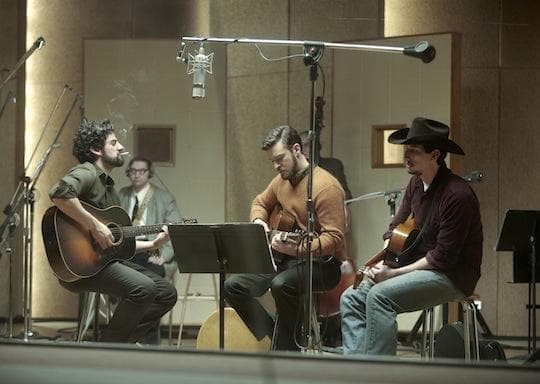Advertisement
The Coens' 'Inside Llewyn Davis': The Other Side Of Freewheelin'
The Coen Brothers’ “Inside Llewyn Davis” opens with a dramatic close-up of a solo mic, illuminated in the smoky dark of a cavernous night club. Llewyn Davis, our hapless hero, takes the stage and sings the traditional folk song “Hang Me, Oh Hang Me.” If we want to get inside Llewyn Davis, we need to listen to the music.
It’s Greenwich Village, 1961. The folk scene is on the verge of exploding, but for now, jazz is king and purist folk musicians, like Llewyn, are relegated to playing basket houses, so called after how the musicians are paid: by passing around a basket. Folk music is one rough business. Even if Llewyn were a better artist — he’s good, but he’s no Bob Dylan — or more willing to compromise, the odds are against him.
So broke he can’t afford a winter coat, Llewyn survives by crashing on friends’ couches and shows his gratitude by insulting his host’s wife and letting their cat loose, and making the wife of another friend pregnant. Llewyn may alienate family and friends, but not all of his solo act is by choice. His musical partner committed suicide.
Small wonder the guy is angry, snarky and depressed.
The film doesn’t lack for humor, unexpected twists and turns, and pungent characters who populate the folk scene. This is a Coen Brothers’ film, after all. Jazz musician Roland Turner (John Goodman) and June (Carey Mulligan), one half of a husband-wife folk duo who is pregnant by Llewyn, throw mean, funny verbal punches at him.
Then there’s the music. As they did in “O Brother, Where Art Thou?”, the Coen Brothers and music producer T Bone Burnett give us the great gift of our own musical history. Songs are performed in their entirety by actor/musician Oscar Isaac, who gives an Oscar-worthy performance as Llewyn, and by other musical talent.
But make no mistake, “Inside Llewyn Davis” is a downbeat, rambling work. The joy the movie brings comes with a heavy heart. Outside it’s relentlessly cold, gray and slushy. Inside is not much better. The small downtown walkups and the music agents’ offices all seem to be painted the same drab, oppressive shade of green and there’s a recurring shot of a claustrophobically narrow high-ceilinged hallway that’s positively Kafkaesque.
When Llewyn isn’t playing music or imposing on people, he’s in transit: walking the streets, riding the subways, and hitching rides. Like his Welsh name, Llewyn’s clothes and his slouch against the cold recall Dylan, but with his guitar in one hand, a cat in other, and no prospects, LLewyn is freewheelin’ gone bad.

He sets out for even snowier Chicago to audition for folk music giant Bud Grossman (based on Albert Grossman, proprietor of Chicago’s Gates of Horn folk night club, who went on to manage Dylan and Janis Joplin). In the dark, empty club, Llewyn plays his heart out, glancing up to see how Grossman is responding, trying to impress and connect with him. It’s as seductive as we ever see Llewyn get. And Grossman listens, really listens, even as he’s calculating the musician’s marketability. The verdict: “I don’t see a lot of money here.” In lesser hands this scene would have played like lead. Instead it’s as graceful as it is devastating.
Earlier Llewyn learned that another woman he made pregnant had the baby by him, and the two are now living in Akron, Ohio. We aren’t often privy to what Llewyn thinks or feels, but things do register with him. On his Chicago road trip, we see him looking at signs for Akron. The gorgeous song “Fare Thee Well (Dink’s Song),” which the film showcases, tells of a woman whose man has made her pregnant and left her.
Folk musician Llewyn is the real deal: a working class kid who did time in the Merchant Marines, just like musician Dave Van Ronk, the inspiration for the character. Llewyn has probably “been all around the world,” just like the storyteller in the song “Hang Me, Oh Hang Me.” Cat lovers may disagree, but at bottom, Llewyn is probably not a bad guy.
Does Llewyn say fare thee well to his musical aspirations and go back to sea? The absence of a back story, exposition, a “music is my life” soliloquy, dramatic changes of fortune, an ill-fitting happy ending, or a definitive conclusion well serve this musical shaggy-dog story (or to be more precise, this musical yellow cat story) that seems to go nowhere, circles back around, and somehow finds its way home.

More
The “Inside Llewyn Davis” website offers a wealth of material including a very good essay, “Before the Flood: Llewyn Davis, Dave Van Ronk and the Village Folk Scene of 1961,” by Elijah Wald, musician and writer who co-authored with Dave Van Ronk “The Mayor of MacDougal Street: A Memoir.”
Kaj Wilson's 7 Reasons To Love The Coen Brothers
Kaj Wilson hosts The Breakfast Film Club at The Coolidge Corner Theatre. She is the former Artistic Director of The Boston Jewish Festival. Reach her at kajwilson@yahoo.com
This program aired on December 20, 2013. The audio for this program is not available.
